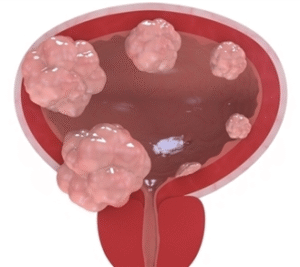Trans-Urethral Resection of Bladder Tumour – TURBT
Trans Urethral resection of bladder tumour with/without MMC
An endoscopic procedure where bladder tumours are excised via the urethra.
Why is it done?
Primary management of:
- Resect a bladder lesion suspicious of bladder cancer
- Three Types of bladder cancer:
-
- Urothelial Carcinoma (85%)
- Squamous Cell carcinoma
- Adeno carcinoma
- Metastatic cancer to the bladder – i.e. Breast, Cervical, Adeno carcinoma of bowel.
- Other space occupying lesions in the bladder: infection granulomas, abscess from diverticulitis etc.
- Abnormal cells suggestive of urothelial carcinoma, on urine cytology.
Risk factors:
- Strong family history of bladder cancer.
- Smokers or passive smokers.
- Factory workers: dyes, paints, etc.
- Exposure to Schistosoma (Bilharzia).
- Renal stone disease, bladder stones.
How is it done?
 This is done under General anesthesia.
This is done under General anesthesia.
- A cystoscopy is performed by placing a camera in the urethra with the help of a lubricant gel and saline irrigation.
- The bladder is then distended with saline.
- A resectoscope is then placed.
- I use Bi-polar resection, thus using saline as irrigation.
- The tumour or tumours are resected as complete as possible.
- Deep resection of the tumour base is done to exclude deep muscle invasive tumours.
- In tumours where it is clearly muscle-invasive, less extensive surgery is done, as this patient may benefit from a cystectomy.
- 40mg of Intravesical Mitomycin C is routinely placed inside your bladder for an hour after the surgery.
- A 3-way catheter is placed with continuous saline irrigation until your urine is clear.
- Antibiotics may be given to prevent infection.

Mitomycin C
Chemotherapeutic agent providing 40% lower incidence of Urothelial Cancer recurrence if placed within 6-8 hours inside the bladder after a TURBT.
What to expect after the procedure?
- Blood stained urine.
- Lower abdominal discomfort which will persist for a few days.
- Catheter induced discomfort.
- NB! Each person is unique and for this reason symptoms vary.
- Small risk (<1%) of bladder perforation, causing you to have a laparoscopy with repair of bladder and wash-out of peritoneal cavity with Sterile Water.
What next?
- You may have a 22 French (thick) 3-way urethral catheter placed through your urethra.
- It does have a channel for placement of constant saline irrigation and another for the drainage of the blood-stained urine.
- The continuous bladder irrigation will continue until your urine is clear approximately 24-48hrs.
- This can also be remedied by drinking plenty of fluids until it clears.
- As soon as the colour of your urine is satisfactory, your catheter will be removed.
- Staging of your cancer will be arranged to be reviewed on your review appointment.
- A ward prescription will be issued to patients on discharge, for own collection at any pharmacy.
- Patients should schedule a follow-up appointment within 7-14 days.
- Please don’t hesitate to direct all further queries to Jo.
- REMEMBER: THOSE WHO SUFFER IN SILENCE, SUFFER ALONE!
Staging
- CT IVP.
- CT Chest.
- Bone scan.
- Renal Function and Liver Function Tests.
- MRI where an allergy to Iodine or Renal Impairment.
Download Information Sheet


Leave a Reply
Want to join the discussion?Feel free to contribute!